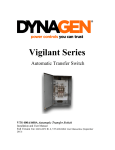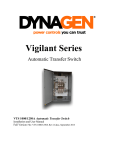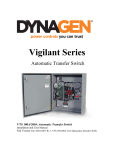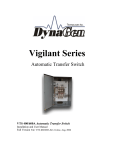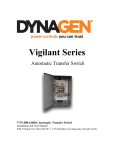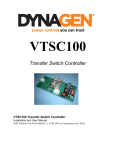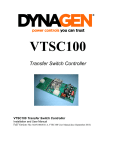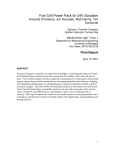Download OWNER`S & INSTALLATION MANUAL
Transcript
400 & 600 AMP OWNER’S & INSTALLATION MANUAL MODEL # Revision 1.3 BOM # 1168497 4.2.15 Milbank | 4801 Deramus Ave., Kansas City, MO 64120 | 877.483.5314 | milbankworks.com California oposition 65 Warning gine exhaust from this product chemicals known to the state of ia to cause cancer, birth defects r other reproductive harm. California Proposition 65 Warning Certain components in this product and its related accessories contain chemicals known to the state of California to cause cancer, birth defects or other reproductive harm. Wash hands after handling. DISCLAIMERS: All information, illustrations and specifications in this manual are based on the latest information available at the time of publishing. The illustrations used in this manual are intended as representative reference views only. Moreover, because of our continuous product improvement policy, we may modify information, illustrations and/or specifications to explain and/or exemplify a product, service or maintenance improvement. We reserve the right to make any change at any time without notice. Some images may vary depending upon which model is shown. ALL RIGHTS RESERVED: No part of this publication may be reproduced or used in any form by any means – graphic, electronic or mechanical, including photocopying, recording, taping or information storage and retrieval systems – without the written permission of Milbank Manufacturing. ORIGINAL INSTRUCTIONS (English): The English version of this manual controls over any error in or conflicting interpretation of any translation. 2 Milbank Vigilant® Owner’s and Installation Manual TABLE OF CONTENTS INTRODUCTION........................................................................................................................................................5 CONTACT INFORMATION..................................................................................................................................5 AUTOMATIC TRANSFER SWITCH (ATS)...........................................................................................................5 GENERATOR.......................................................................................................................................................5 SAFETY.....................................................................................................................................................................6 IMPORTANT SAFETY INSTRUCTIONS..............................................................................................................6 Safety Symbol Meanings...............................................................................................................................6 SAFETY LABELS................................................................................................................................................7 GENERAL SAFETY PRECAUTIONS..................................................................................................................7 SPECIFICATIONS......................................................................................................................................................8 VIGILANT® 400A/600A SPECIFICATIONS..........................................................................................................8 VIGILANT® PRODUCT SERIES................................................................................................................................9 VIGILANT® PRODUCT OVERVIEW....................................................................................................................9 RECEIVING, HANDLING AND STORAGE..........................................................................................................9 Receiving ......................................................................................................................................................9 Handling......................................................................................................................................................10 Storage........................................................................................................................................................10 VIGILANT® CATALOG NUMBER IDENTIFICATION..........................................................................................10 INSTALLATION AND WIRING.................................................................................................................................11 GENERAL INFORMATION................................................................................................................................11 MOUNTING LOCATION....................................................................................................................................11 MOUNTING REQUIREMENTS..........................................................................................................................11 RECOMMENDED UPSTREAM PROTECTION.................................................................................................11 POWER CONNECTIONS..................................................................................................................................11 CONNECTIONS................................................................................................................................................12 GENERAL OPERATION..........................................................................................................................................14 VIGILANT® SERIES GENERAL OPERATION...................................................................................................14 ADJUSTMENTS AND SETTINGS...........................................................................................................................15 VIGILANT® SERIES ADJUSTMENTS AND SETTINGS....................................................................................15 System Adjustments....................................................................................................................................16 120/240V or 277/480V AC: Switch #1...................................................................................................16 50/60 HZ: Switch #2..............................................................................................................................16 Load/No Load: Switch #3......................................................................................................................16 Under/Over Voltage: Switch #4, 5, 6.....................................................................................................16 Under/Over Frequency: Switch #7, 8, 9................................................................................................16 Timing Adjustments.....................................................................................................................................17 Testing Adjustments....................................................................................................................................18 Controller test switch.............................................................................................................................18 Remote test switch ...............................................................................................................................18 Exerciser...............................................................................................................................................18 MANUAL TRANSFER..............................................................................................................................................19 MANUAL TRANSFER OF MECHANISM...........................................................................................................19 400A Manual Transfer..................................................................................................................................19 600A Manual Transfer..................................................................................................................................20 MAINTENANCE.......................................................................................................................................................21 RECOMMENDED MAINTENANCE...................................................................................................................21 MAINTENANCE.................................................................................................................................................21 DRAWINGS..............................................................................................................................................................22 MGVATS4001480 – 400A – 480V GENERAL ARRANGEMENT.......................................................................22 MGVATS6001480 – 600A – 480V GENERAL ARRANGEMENT.......................................................................23 MGVATS4001240 – 400A – 240V WIRING DIAGRAM......................................................................................24 MGVATS4001208 – 400A – 208V WIRING DIAGRAM......................................................................................25 MGVATS4001480 – 400A – 480V WIRING DIAGRAM......................................................................................26 MGVATS6001240 – 600A – 240V WIRING DIAGRAM......................................................................................27 MGVATS6001208 – 600A – 208V WIRING DIAGRAM......................................................................................28 MGVATS6001480 – 600A – 480V WIRING DIAGRAM......................................................................................29 Milbank Vigilant® Owner’s and Installation Manual 3 TABLE OF CONTENTS EXERCISER.............................................................................................................................................................30 ENGINE EXERCISER AND EXTERNAL LED ANNUNCIATION.......................................................................30 Introduction..................................................................................................................................................30 Clearing the Exerciser.................................................................................................................................31 Set Current Time and Date..........................................................................................................................31 Set Program Timing.....................................................................................................................................31 Program Review..........................................................................................................................................31 ON/AUTO/OFF Mode..................................................................................................................................31 WARRANTY.............................................................................................................................................................32 MILBANK MANUFACTURING VIGILANT® OWNER WARRANTY POLICY......................................................32 Limited Warranty..........................................................................................................................................32 Warranty Period...........................................................................................................................................32 Warranty Registration Process....................................................................................................................32 About Our Warranty.....................................................................................................................................32 4 Milbank Vigilant® Owner’s and Installation Manual INTRODUCTION Thank you for your purchase of a Milbank Vigilant® Series Automatic Transfer Switch (ATS). This product is designed for use with standby generators. This ATS may have different installation requirements depending on the generator manufacturer or design. When operated and maintained according to the instructions in this manual, your system will provide many years of standby electrical energy service. This manual contains important safety instructions for installation and operation of this ATS. We have made every effort to provide safe, efficient instructions for installation and operation. However, as every installation is unique, it is impossible to anticipate every possible procedure and method to obtain a properly installed unit. It is important that you read and understand these instructions thoroughly before attempting to install or operate this unit. Your equipment is supplied with this combined Installation and User Manual. This is an important document and should be retained by the owner after the installation has been completed. An electronic version can be downloaded at milbankworks. com. This ATS requires professional installation before use. Refer to the installation section of this manual for instructions on installation procedures. Only licensed electrical contractors should install an ATS. Installations must comply completely with all federal, state and local codes, standards and regulations. Your installer should follow these instructions completely. Every effort has been made to ensure that the information in this manual is both accurate and current. However, the manufacturer reserves the right to change, alter or otherwise improve the system at any time without prior notice. CONTACT INFORMATION There are several ways to contact us for answers to questions you may have about your product. Contact Technical Services by phone at (816) 410-7346, Monday through Friday, 8 a.m. to 5 p.m, Central Time. Electronic communication can be made through our website milbankworks.com where you can locate an authorized repair technician, or by email at [email protected]. For your future reference, record the following pertinent information. This information will help to identify product information should you need to contact Milbank’s Technical Services department. ATS Model Number: ________________________________ Description: ___________________________________ Serial Number: ________________________________ Installation Date: _______________________________ GENERATOR Model Number: ________________________________ Description:___________________________________ Serial Number: ________________________________ Installation Date: _______________________________ NOTICE Please check with the generator manufacturer to ensure the Vigilant® switch is compatible. Milbank Vigilant® Owner’s and Installation Manual 5 SAFETY IMPORTANT SAFETY INSTRUCTIONS Read Manufacturer’s Instructions. SAVE THESE INSTRUCTIONS. • This manual contains important information that should be used during installation, maintenance and operation of this unit. • Read all the instructions and safety symbols thoroughly before attempting to install, operate and/ or service this equipment. Safety Symbol Meanings Symbol ! Description Safety Alert Symbol Crush Hazard Electrical Shock Hazard ! This safety alert symbol appears with most safety statements. It means attention, become alert, your safety is involved! Please read and abide by the message that follows the safety alert symbol. ! DANGER Indicates a hazardous situation which, if not avoided, will result in death or serious injury. ! WARNING Indicates a hazardous situation which, if not avoided, could result in death or serious injury. ! CAUTION Indicates a hazardous situation which, if not avoided, could result in minor or moderate injury. NOTICE Indicates a situation which can cause damage to the equipment, personal property and/or the environment, or cause the equipment to operate improperly. NNOTE: Indicates a procedure, practice or condition that should be followed in order for the generator to function in the manner intended. The manufacturer of this product cannot reasonably anticipate every possible circumstance that might involve a hazard. The warnings in this manual and the tags and decals affixed to the unit are, therefore, not all-inclusive. If you use a procedure, work method or operating technique that the manufacturer does not specifically recommend, you must ensure that your method is safe for you and others. You must also make sure that the procedure, work method or operating technique that you choose does not render the equipment unsafe. 6 Milbank Vigilant® Owner’s and Installation Manual SAFETY SAFETY LABELS Always replace any illegible or missing labels immediately. All safety labels must be legible to alert personnel to safety hazards. ! WARNING The safety messages that follow have WARNING level hazards. • Failure to properly ground equipment can result in electrocution. • Do not touch bare wires. • Do not use equipment with worn, frayed, bare or otherwise damaged wiring. • Do not handle electrical cords while standing in water, while barefoot, or while hands or feet are wet. Figure 1 – Milbank PN 1168019 GENERAL SAFETY PRECAUTIONS ! DANGER DANGER! Equipment contains high voltage. Despite the safe design of the system, operating this equipment imprudently, neglecting its maintenance or being careless can result in death or serious injury. ! WARNING The safety messages that follow have WARNING level hazards. • Unauthorized or improper installation, operation, application or repair of this equipment is extremely dangerous. • Only qualified electricians should attempt installation of this equipment, which must strictly comply with all applicable codes, standards and regulations. • When connecting a generator system to an electrical system that is normally supplied by an electric utility company, always comply with regulations of the National Electrical Code (NEC) (Article 701 Legally Required Standby Systems or Article 702 Optional Standby Systems, as applicable), and Occupational Safety and Health Administration (OSHA), as applicable. It is essential to use the latest version of any standard to ensure all current information is applied. Milbank Vigilant® Owner’s and Installation Manual • If you must work around a unit while it is operating, stand on an insulated dry surface to reduce shock hazard. • Do not allow unqualified persons or children to service equipment. • In case of an accident caused by electrical shock, immediately shut down all sources of electrical power and contact local authorities. Avoid direct contact with the victim. • Low-voltage wire cannot be installed in the same conduit as power voltage wiring. • Dangerous power voltages are present inside a live ATS. Never work on the ATS unless all power voltage supplies to the switch have been turned off. • When an ATS is connected to a standby generator, the generator engine may crank and start at any time without notice to the end user. To avoid injury that may be caused by such start-ups, move the safety disconnect switch on the front panel to the OFF position before working on this equipment. NOTICE Improper treatment of equipment can damage it and shorten its life. • Use equipment only for intended uses. • If you have questions about intended use, ask a Milbank certified technician or contact Milbank Manufacturing’s PowerGen™ division. • Do not expose equipment to excessive moisture, dust, dirt or corrosive vapors. • Remain alert at all times while working on this equipment. Never work on the equipment when you are physically or mentally fatigued. • If connected devices overheat, turn them off and turn off their circuit breaker or fuse. 7 SPECIFICATIONS VIGILANT® 400A/600A SPECIFICATIONS Vigilant® series transfer switches do not support Delta configurations. UL1008 Emergency Standby rated AC current rating 400/600A, 2-pole, 3-pole AC voltage rating 120/240V, 120/208V, 277/480V AC voltage sensing is line to neutral.1 Ambient temperature rating 113°F (45°C) at 400A/600A 131°F (55°C) at 360A/540A 149°F (65°C) at 300A/450A 158°F (70°C) at 280A/420A Do not exceed 158°F (70°C) RSC rating 10A maximum DC operating voltage 12/24V DC (Voltage Range 9-30V DC) DC power consumption Control setting ranges Over/under voltage sensing* 25 mA @ 12V DC Function Range Setting Time Delay Engine Start (TDES) 3-32 seconds 13 seconds (1.56V DC@ TP J2-1) Time Delay Normal (Utility) to Emergency (Generator) (TDNE) 11-64 seconds 21 seconds (0.78V DC@ TP J2-2) Time Delay Emergency (Generator) Transfer to Normal (Utility) (TDEN) 9-256 seconds 256 seconds (5.00V DC@ TP J2-3) Time Delay Engine Cooldown (TDEC) 0-256 seconds 256 seconds (5.00V DC@ TP J2-4) Time Delay Neutral Position (TDNP) (600A only) 0-64 seconds 10 seconds (0.78V DC@ TP J2-5) Normal Line Sensing Under Voltage Dropout (11-18%) Pickup (6-13%) (±2% accuracy) Dropout (18%) Pickup (13%) (±2% accuracy) Normal Line Sensing Under Frequency 5-12% (±1% accuracy) 12% (±1% accuracy) Emergency Line Sensing Under Voltage Dropout (11-18%) Pickup (6-13%) (±2% accuracy) Dropout (18%) Pickup (13%) (±2% accuracy) Dropout (11-18%) Pickup (6-13%) adjustable Percentage above or below normal voltage to recognize an unacceptable voltage condition (±2% accuracy). Over/under frequency sensing Exerciser timer Test switch UL withstand/closing ratings Lug capacities Overall dimensions Weight 1 5-12% adjustable Percentage above or below normal frequency to recognize an unacceptable frequency condition (±1% accuracy). Included Included 10,000A with properly rated 600A circuit breaker @ 480V (400A) 12,000A with properly rated 800A circuit breaker @ 480V (600A) 400A – 4 to 600 MCM 600A – 2 to 600 MCM 400A/Enclosure – 48 x 30 x 12 in. (121.9 x 76.2 x 30.5 cm) 600A/Enclosure – 60 x 30 x 24 in. (152.4 x 76.2 x 70.0 cm) 400A @ 235 lb (107 kg), 600A @ 425 lb (193 kg) One of the connected L-N phases must be below the under-voltage threshold to initiate transfer sequence. 8 Milbank Vigilant® Owner’s and Installation Manual VIGILANT® PRODUCT SERIES VIGILANT® PRODUCT OVERVIEW Milbank Vigilant® series automatic transfer switches are represented by the MGVATS product identifier designed with all required sensing circuitry provided. The sensing circuitry allows automatic transfer of an electrical load to a standby power source in the event of an over/under voltage or frequency condition on any or all phases of the utility power source. Upon the restoration of the utility supply, the electrical load will be automatically retransferred to the utility power source. All Vigilant® transfer switch mechanisms incorporate a double-throw action switching device for automatic transferring. The Vigilant® transfer switch mechanism is a contactor-operated device controlled by a set of utility and generator solenoids. Manual operation is also provided for manual transfer of the load between the power sources if necessary. Figure 2 – VTS2000 Series RECEIVING, HANDLING AND STORAGE Shipment contents: • Vigilant® Series – Automatic Transfer Switch • Installation and User Manual • Warranty card Receiving Every effort is made to ensure that your Vigilant® transfer switch arrives at its destination undamaged and ready for installation. The packing is designed to protect the transfer switch’s internal components as well as the enclosure. Care should be taken to protect the equipment from impact at all times. Do not remove the protective packaging until the equipment is at the installation site and ready to be installed. After unpacking, inspect the switch for any damage that may have occurred during shipping. If any missing parts or damage is discovered when unpacking, do not return the unit to the place of purchase; please contact Milbank Technical Services for instructions on how to proceed. Never install a switch that has been damaged. A shipping label affixed to the shipping box includes a variety of product and shipping information, such as items and customer numbers. Make certain that this information matches your order information. Milbank Vigilant® Owner’s and Installation Manual 9 VIGILANT® PRODUCT SERIES Handling As previously mentioned, each Vigilant® transfer switch is packaged in its own individual box. Protect the equipment from impact at all times and do not double stack. Once the transfer switch is at the installation site and ready to be installed, the packaging material may be removed. VIGILANT® CATALOG NUMBER IDENTIFICATION Storage Although well packaged, this equipment is not suitable for outdoor storage. If the transfer switch is to be stored indoors for any period of time, it should be stored with its protective packaging in place. Protect the transfer switch at all times from excessive moisture, dirty conditions, corrosive conditions and other contaminants. It is strongly recommended that the package-protected equipment be stored in a climate-controlled environment of -4° to 149°F (-20° to 65°C), with a relative humidity of 80% or less. Do not stack other equipment on top of the stored switches. Figure 3 – Milbank PN 1168761 10 Milbank Vigilant® Owner’s and Installation Manual INSTALLATION AND WIRING GENERAL INFORMATION All Vigilant transfer switches are factory-tested and approved. Installation requires the mounting of the transfer switch as well as all external wiring for utility and generator operation. Once the transfer switch is properly installed, it should be visually inspected and approved before any testing is performed. ® MOUNTING LOCATION IMPORTANT: Vigilant® series transfer switches do not support Delta configurations. ! WARNING Always use adequate lifting to lift and mount the transfer switch during installation. All Vigilant® transfer switches require that adequate lifting means are used to install the switch at its mounting location. Be certain to choose a location that offers a flat mounting surface that is capable of supporting the transfer switch (see Vigilant® 400A/600A Specifications on page 8 for proper weight details). Caution must be taken at the installation site to make sure the site is free from excessive moisture, fluctuating temperature ranges, dust, corrosive materials, etc. Before any drilling takes place, be certain the drilling area is free of any hazards including electrical wiring, piping, etc. Extreme caution should be exercised when any installation and drilling are performed to protect the transfer switch from any debris including contaminants, filings, etc. Any debris within the transfer switch may result in a system malfunction. MOUNTING REQUIREMENTS The enclosure has a NEMA (National Electrical Manufacturer’s Association) type 3R rating and is suitable for indoor/outdoor installations and provides a degree of protection against falling rain and sleet. Guidelines for mounting the unit include: • Ensure that the mounting surface can support the weight of the switch and adheres to all local codes. • The enclosure must be installed with NEMA type 3R hardware and connections. • Level and plumb the unit enclosure to prevent deformation. • Never install the switch where any corrosive substance may come in contact with the enclosure. • Protect the switch at all times against excessive moisture, dust, dirt, lint, construction grit and corrosive vapors. Milbank Vigilant® Owner’s and Installation Manual RECOMMENDED UPSTREAM PROTECTION When protected by a circuit breaker rated at 600A maximum for 400A rated transfer switches, this switch is suitable for use on a circuit capable of delivering not more than 10,000A RMS SYMMETRICAL AT 480V. When protected by a circuit breaker rated at 800A maximum for 600A rated transfer switches, this switch is suitable for use on a circuit capable of delivering not more than 12,000A RMS SYMMETRICAL AT 480V. Use copper or aluminum wiring 60/75C rating for power terminals. ! CAUTION Using upstream protection devices other than the recommended circuit breakers may cause improper operation of the Vigilant® switch. ! WARNING Always de-energize power connections before installing any connections. Power lines may carry high voltage. Exercise extreme caution when installing any power connections to the Vigilant® switch. POWER CONNECTIONS Proper power cables need to be installed to the transfer switch and should be installed by licensed electrical contractors. Improper installation or connections of these power cables are extremely dangerous and may cause severe injury or death. All power connections are to be connected to the proper lugs, which are included on the switch contactor and neutral block assembly. Connect the utility, generator, neutral and load cables to the terminals, which are clearly marked on the transfer switch (see Figure 5). Verify that all connections are correct before tightening lugs. All power cable lug connections must be tightened to the proper torque values as shown in Table 1. ! WARNING Low-voltage wire cannot be installed in the same conduit as power voltage wiring. It could result in shock due to short circuit as well as cause electromagnetic interference resulting in non-operation of the system. 11 INSTALLATION AND WIRING CONNECTIONS Utility Cable Lugs N.O. dry contacts Generator SPST (Optional) Remote Start Contacts – To Generator Generator Cable Lugs Battery + Battery - Transfer Switch (Internal) - + 12/24VDC Generator Battery Load Cable Lugs Neutral Lugs Figure 5 Figure 4 – Power Cable Connection Locations ! WARNING On 600A models, always install the transparent protective shields covering the power connections of the switch mechanism once the proper connections are performed. Table 1: 400-600A Lug Torque Values Internal Socket Size Across Flats Tightening Torque 1/2 in. (13 mm) 500 in-lb (56 N·m) Wire size range 4 to 600 MCM copper using Ilsco lug # TA-500-S for 400A systems Wire size range 2 to 600 MCM copper using Ilsco lug # PB2-600 for 600A systems Figure 6 NNOTE: The transfer switch consists of the 6-position terminal block (shown in Figure 6) for connections. Battery + and Battery - must be connected for operation of the VTSC100 controller. The battery is either 12V DC or 24V DC. A 1A fuse should be placed on the Battery + connection. Do not use an isolated power supply to power the controller as the controller requires a reference to neutral for AC sensing, which it obtains from the distribution system via Battery -. RSC1 and RSC2 need to be connected to the remote start/stop connections of the generator to allow automatic starting. These are N.O. dry contacts. 12 Milbank Vigilant® Owner’s and Installation Manual INSTALLATION AND WIRING An optional customer-supplied test switch may be installed by the customer using the TEST 1 and TEST 2 terminals. A closed circuit between the test connections will simulate a utility failure. See wiring diagram for details. The battery charger needs to be of high quality. Lowquality battery chargers will often go into full recharge mode due to VTS2 controller current draw. This will quickly wear out the battery. Milbank Vigilant® Owner’s and Installation Manual 13 GENERAL OPERATION VIGILANT® SERIES GENERAL OPERATION The Vigilant® switch in combination with the VTSC100 timing module will allow for the automatic transfer of an electrical load to a standby power source in the event of an over/under voltage or frequency condition on any or all phases of the utility power supply. In the event of an over/under voltage or frequency condition of utility power, the onboard VTSC100 sensing circuitry will begin the initiation of the transfer process. Upon initial sensing of a loss of utility power, the Vigilant® transfer switch is specifically designed to allow an engine start time delay period (TDES) to expire before starting the generator. This engine start time delay is user-adjustable from the VTSC100, preventing unnecessary engine starts from a temporary loss of utility. In the event the utility source is not restored after the engine start time delay has expired, the remote contacts will close, sending a signal to the generator’s automatic start controller. When the VTSC100 senses that the generator has started, and is within acceptable limits, the transfer switch will wait until the utility to generator time delay (TDNE) has expired before switching to the neutral position. While in the neutral position, the transfer switch will transfer back to utility supply if the utility is restored. With no utility source, the transfer switch will stay in the neutral position until the delay on neutral time has expired, allowing the transfer switch to temporarily stop at the neutral position during either the utility to generator or generator to utility transfers. The temporary stop allows controlled isolation between both utility and generator sources. After the neutral delay has expired, the transfer switch will complete the transfer to the destination source. All connected loads will be transferred to the generator power source. 14 While the transfer switch is in the generator position, the VTSC100 will constantly monitor the utility source voltage and frequency status. Once the utility source is restored, the transfer switch will wait until the generator to utility time delay (TDEN) has expired before switching to the neutral position. The TDEN delay is useradjustable from the VTSC100 to prevent unnecessary transfers caused by momentary utility restoration conditions. If the utility source remains stable after the generator to utility time delay expires, the transfer switch will transfer to the neutral position. The transfer switch will stay in the neutral position until the delay on neutral time has expired. If the utility source fails during this delay period, there will be a transfer back to the generator position. When the delay on neutral time expires, the transfer switch will transfer to the utility position. All connected loads are transferred to the utility power source. When connected loads are transferred back to the utility power source, an engine cooldown period (TDEC) will be initiated, allowing the generator to run in a no-load condition. This engine cooldown time delay is useradjustable from the VTSC100, allowing the generator to continue running for an adjustable period after the utility is restored. Milbank Vigilant® Owner’s and Installation Manual ADJUSTMENTS AND SETTINGS The Vigilant® series adjustments and settings may be made from the onboard VTSC100 transfer switch controller. The general settings and adjustments are as follows. See the VTSC100 controller user manual for detailed information on adjustments. VIGILANT® SERIES ADJUSTMENTS AND SETTINGS ! DANGER Never adjust settings on the transfer switch controller while the controller is energized. Always completely isolate all power sources from the controller and transfer switch mechanism before making any adjustments. Figure 7 12/24 VDC OPERATION Jumper not Jumper not The VTSC100 controller is designed to operate in a 12 OR 24 VDC installedinstalled system voltage. for 24VDC for 24VDC In 12VDC system operation, the controller requires that jumpers be installed in the 12/24VDC jumper location. Jumper Jumper installed installed for 12VDC for 12VDC In 24VDC system operation, the controller requires that no jumpers be installed in the 12/24VDC jumper location. A total of five jumpers need to be installed for 12VDC operation as illustrated. Installing jumpers in the 12/24 VDC jumper locations for 24VDC system operation may damage the VTSC100 controller. Jumper Jumper Jumper Jumper Jumper Jumper Jumper Jumper Jumper Jumper Figure 8 – – 12/24 VDC Operation Milbank Vigilant® Owner’s and Installation Manual 15 ADJUSTMENTS AND SETTINGS System Adjustments Table 2: Dip Switch Settings Feature Switch Settings Set Function Set Function Set Function Set Function Set Function Set Function Set Function 1 Keep in OFF position at all times OFF – OFF – – – – – – – – – – – 2* Set the unit for 50/60Hz systems ON 60 Hz OFF 50 Hz – – – – – – – – – – 3* Weekly exercise with load/no load ON Load test cycle OFF No load test cycle – – – – – – – – – – 4 5 OFF Set the over/under voltage setting 6 7 8 OFF OFF Dropout v 18% Pickup v 13% OFF OFF Set the over/under frequency setting ON OFF ON ON ON Dropout v 15% Pickup v 10% ON OFF 11% OFF OFF Dropout v 16% Pickup v 11% OFF OFF 12% OFF OFF Dropout v 17% Pickup v 12% OFF OFF 10% ON OFF ON Dropout v 14% Pickup v 9% ON ON 9% ON OFF ON OFF ON 8% OFF ON Dropout v 13% Pickup v 8% Pickup v 7% ON 7% OFF Dropout v 12% 6% ON No Function: Switch #1 The dip switch #1 should remain in the off position at all times. 50/60 HZ: Switch #2 The dip switch located on the VTSC100 is used to set the unit for 50 or 60 Hz systems. When switch location #2 is on, the system is configured for 60 Hz. When switch location #2 is off, the unit is configured for 50 Hz systems. Load/No Load: Switch #3 The dip switch located on the VTSC100 may be used for load/no-load exerciser testing. When switch location #3 is on, the system is configured for a load test condition allowing transfer to a generator power source. When switch location #3 is off, the unit is configured for a no-load test condition with no transfer to a generator power source. This setting applies to the engine exerciser test only. See the VTSC100 user manual for a more advanced and detailed outlook. Under/Over Voltage: Switch #4, 5, 6 The dip switch located on the VTSC100 may be used to set the Over/Under voltage setting. Depending upon the positions of dip switch locations 4, 5 and 6, the VTSC100 will determine the percentage range to recognize a utility failure. The failure percentage adjustments can range from 11 to 18 percent of the utility power source for dropout and 6 to13 percent for pickup. Switch 4, 5 and 6 off for 18% and on for 11% dropout. See the VTSC100 user manual for a more advanced and detailed outlook. Under/Over Frequency: Switch #7, 8, 9 The dip switch located on the VTSC100 is used to set the Over/Under frequency setting. Depending upon the positions of dip switch locations 7, 8 and 9, the VTSC100 will determine the percentage range to recognize a utility failure. The failure percentage adjustments can range from 5 to 12 percent of the utility power source. Switch 7, 8 and 9 off for 12% and on for 5% range. See the VTSC100 user manual for a more advanced and detailed outlook. Timing Adjustments 16 Milbank Vigilant® Owner’s and Installation Manual ADJUSTMENTS AND SETTINGS Figure 9 TDES: Time Delay Engine Start: This delay prevents unnecessary engine starts. When the VTSC100 determines a utility failure, it will wait for the engine start time delay to expire before trying to start the generator. TDNE: Time Delay Normal (Utility) to Emergency (Generator): This delay allows the generator to stabilize before any load is transferred. This normal (utility) to emergency (generator) time delay allows the generator to be fully running before supplying power to a load. TDEN: Time Delay Emergency (Generator) to Normal (Utility): This delay allows the utility source to be monitored for stability. This emergency (generator) to normal (utility) time delay allows the utility to be monitored for the set amount of time to confirm that it is fully restored and stable. TDEC: Time Delay Engine Cool: This delay allows the engine to continue running after the transfer switch returns to the normal (utility) position. When the VTSC100 recognizes that the transfer switch is in the normal (utility) position after an emergency (generator) to normal (utility) transfer, the generator will continue to run under a no-load condition until the engine cool time delay has expired. TDNP: Time Delay Neutral Position: This delay allows the transfer switch to temporarily stop between normal (utility) to emergency (generator) and emergency (generator) to normal (utility) transfers. The temporary stop allows controlled isolation between the both normal (utility) and emergency (generator) sources. (Not available on the 400A switch.) Testing Adjustments Controller test switch Manual testing of the Vigilant® transfer switches may be achieved by manual adjustment of the test switch located on the VTSC100. The controller test switch will allow manual testing of the transfer switch. The purpose of the test switch is to simulate a utility power failure. Normally the test switch would be set to the utility position, allowing proper sensing for normal utility faults. To simulate a utility fault when no fault actually exists, the test switch would be set to the test position, allowing the transfer switch to transfer to the generator position. After testing, utility power can be restored simply by setting the test switch back to the utility position. Remote test switch The remote test switch will allow remote testing of the transfer switch. The purpose of the test switch is to simulate a utility power failure. The remote test switch may be installed by a licensed electrical contractor; the Milbank Vigilant® Owner’s and Installation Manual 17 ADJUSTMENTS AND SETTINGS switch would be installed at the TEST 1 and TEST 2 on the terminal block. Normally the test switch would be set to the DISABLE position, allowing proper sensing for normal utility faults. To simulate a utility fault when no fault actually exists, the test switch would be set to the ENABLE position, allowing the transfer switch to transfer to the generator position. A SPST test switch rated at a minimum of 1A should be used. MANUAL TRANSFER OF MECHANISM Exerciser The purpose of the exerciser is to perform a test of the transfer switch either manually or automatically. The exerciser may be adjusted by a licensed electrical contractor to any specific time or day in which to perform a test. The exerciser can perform a test for a load or no-load condition. For details instructions on operational and setting instructions, see ENGINE EXERCISER AND EXTERNAL LED ANNUNCIATION on page 30. ! WARNING Never perform a manual transfer while the transfer switch is under load. Manual transfer is not recommended. If performing an emergency manual transfer, be certain to isolate the transfer switch from all power and load sources. Manual transferring is not recommended. If the transfer switch fails to transfer in an emergency, an optional manual transfer may be performed. Caution must be taken to confirm that the transfer switch is isolated from all possible load sources before transferring. Significant force must be supplied to the removable lever handle to perform the transfer. When performing a mechanical transfer, the contactor must be properly activated. 400A Manual Transfer In 400A transfer switches, the manual transfer lever located on the contactor is used to manually transfer between the utility and generator position. A separate removable lever handle is used to transfer the mechanism. The transfer switch is in the utility position when reference A on the contactor is set to the ON position and reference B is set to the OFF position. The transfer switch is in the generator position when reference A on the contactor is set to the OFF position and reference B is set to the ON position. The mechanism is transferred by moving the lever handle in the down position. See transfer instructions 18 Milbank Vigilant® Owner’s and Installation Manual MANUAL TRANSFER on the switch mechanism. Never transfer under a load condition. Always remove the handle from the manual transfer lever location after each transfer. ! WARNING Never allow the removable lever handle to come in contact with live wires or terminals. Figure 10 – Removable Lever Handle Manual Transfer Lever Utility A = On B = Off Generator A = Off B = On Figure 11 – Manual Transfer Lever Location Milbank Vigilant® Owner’s and Installation Manual 19 MANUAL TRANSFER 600A Manual Transfer To transfer from Utility to Generator position: In 600A transfer switches, the manual transfer lever (M) located on the contactor is used to manually transfer between the utility and generator position. A separate removable lever handle is used to transfer the mechanism. See transfer instructions on the switch mechanism. Never transfer under a load condition. Always remove the handle from the manual transfer lever location after each transfer. 1. Push “Trip” using an object such as a screwdriver to open the utility poles. ! WARNING Never allow the removable lever handle to come in contact with live wires or terminals. 2. Set the removable handle on “M” and operate in the UP direction while pushing “select” with the screwdriver. To transfer from Generator to Utility position: 1. Push “Trip” using an object such as a screwdriver to open the generator poles. 2. Set the removable handle on “M” and operate in the UP direction. The transfer switch is in the utility position when reference A on the contactor is set to the ON position and reference B is set to the OFF position. The transfer switch is in the generator position when reference A on the contactor is set to the OFF position and reference B is set to the ON position, as seen in 400A Manual Transfer on page 18. The switch should need to be transferred manually only in the event of a failure within the VTS controls. Please call technical support if any transfer failures are observed. Figure 12 – Removable Lever Handle Up M Trip Se le c t Figure 13 – Manual Transfer Lever Location 20 Milbank Vigilant® Owner’s and Installation Manual MAINTENANCE RECOMMENDED MAINTENANCE ! WARNING Always isolate the transfer switch from all possible power sources when performing maintenance on the mechanism. Periodically inspect all terminals (load, line and control) and all fasteners for any loose parts or wiring. Periodically inspect all terminals (load, line and control) and all fasteners for tightness. Test the transfer switch operation upon initial installation. Periodically check for any excessive wear on any mechanical operating parts or wiring connections. Clean or replace parts when necessary. All transfer switch parts are made of corrosion-resistant material or are plated, coated or painted for corrosion protection. Table 3: Procedure Action Make the transfer switch safe for inspection and maintenance Disconnect all possible power sources before switch inspection. Inspect the transfer switch location for possible safety hazards Inspect mounting location for any safety or fire hazards. Inspect for dirt, wiring damage and mechanical damage. Inspect the transfer switch for loose hardware Check all hardware including controller, exerciser, terminals, etc. for any looseness due to vibrations, etc. Check for any overheating due to loose connections Check for any discoloration, melting or blistering of wiring or connections. Perform regular testing of the transfer switch Perform regular testing of the switch to check for proper operation in case of emergency. MAINTENANCE Always maintain a 3 feet (92 cm) clearance around the Vigilant® transfer switch. Once a month, visually inspect the outside of the switch for accumulation of dirt, moisture and/or corrosion on the enclosure. The homeowner or end user is responsible for following all maintenance and periodic testing procedures and guidelines of the generator owner’s manual to ensure proper operation. Once a year, have a licensed electrician clean the inside of the switch and inspect for: • Damage or loose parts • Discoloration of wire insulation or components Milbank Vigilant® Owner’s and Installation Manual 21 DRAWINGS MGVATS4001480 – 400A – 480V GENERAL ARRANGEMENT 22 Milbank Vigilant® Owner’s and Installation Manual DRAWINGS MGVATS6001480 – 600A – 480V GENERAL ARRANGEMENT Milbank Vigilant® Owner’s and Installation Manual 23 DRAWINGS MGVATS4001240 – 400A – 240V WIRING DIAGRAM 24 Milbank Vigilant® Owner’s and Installation Manual DRAWINGS MGVATS4001208 – 400A – 208V WIRING DIAGRAM Milbank Vigilant® Owner’s and Installation Manual 25 DRAWINGS MGVATS4001480 – 400A – 480V WIRING DIAGRAM 26 Milbank Vigilant® Owner’s and Installation Manual DRAWINGS MGVATS6001240 – 600A – 240V WIRING DIAGRAM Milbank Vigilant® Owner’s and Installation Manual 27 DRAWINGS MGVATS6001208 – 600A – 208V WIRING DIAGRAM 28 Milbank Vigilant® Owner’s and Installation Manual DRAWINGS MGVATS6001480 – 600A – 480V WIRING DIAGRAM Milbank Vigilant® Owner’s and Installation Manual 29 EXERCISER ENGINE EXERCISER AND EXTERNAL LED ANNUNCIATION Introduction All Vigilant® 2000 series transfer switches include an external engine exerciser and LED annunciation. The engine exerciser is easily adjustable from outside the transfer switch enclosure. External LED indication is included on all Vigilant® 2000 series switches, allowing visual controller status. The user may set the engine exerciser to simulate a utility power failure and test the functionality of the transfer switch system. The exact day and time may be specified for testing. External LED indication is available for utility available, generator NEMA 3 available, transfer to utility, transfer to generator and exercise/test run. Illumination is explained in detail in the VTSC100 user manual. The functions of the exerciser time clock are listed below. The exercise time clock is used to set specific times to test the transfer switch operation. The RESET button initializes the time clock, erasing any previous program. The following sections will explain how to: Figure 15 – NEMA 3 1. Set curent time and date 2. Set program timing 3. Review your program 4. ON/AUTO/OFF mode Figure 16 Figure 14 30 Milbank Vigilant® Owner’s and Installation Manual EXERCISER NNOTE: The exerciser clock has a backup battery. The clock runs off the battery when utility power is not available. The battery is not rechargeable. Clearing the Exerciser Program Review 1. Repeatedly press TIMER button to advance the display to each subsequent ON or OFF user setting. 2. The user-set days and times will be displayed. Clear the timer before continuing. To do this, press the round button just above the MIN button. 3. To make a change in a specific setting, repeat Set Program Timing on page 31. Set Current Time and Date ON/AUTO/OFF Mode 1. Press CLOCK and DAY buttons until the current day shows. Release both buttons for current day setting. 1. The ON/AUTO/OFF mode may be selected by pressing the manual button. 2. Press CLOCK and HOUR buttons until the current hour shows. Release both buttons for current hour setting. 3. Press CLOCK and MIN buttons until the current minute shows. Release both buttons for current minute setting. Set Program Timing 1. Press the TIMER button on the exerciser clock. The “1ON” will appear at the left side of the display. The “1ON” represents when the testing start will begin. 2. Press the DAY button to select the program day period. There are 15 possible choices to choose from, which can be selected by repeatedly pressing the DAY button. The 15 possible selections are: 1. Mo. to Su 6. Fr. 11. Mo. to Sa. 2. Mo. 7. Sa. 12. Mo. to We. 3. Tu. 8. Su. 13. Th. to Sa. 4. We. 9. Mo. to Fr. 14. Mo., We., Fr. 5. Th. 10. Sa. to Su. 15. Tu., Th., Sa. 3. Press the HOUR button to set the hour. 4. Press the MIN button to set the minute. 5. After setting the above testing start time, press the TIMER button. After the TIMER button is pressed, the “1OFF” will appear at the left side of the display. The “1OFF” represents when the testing will end. 6. Repeat steps 2, 3 and 4 to set the time when the system test is to end. 7. Press the CLOCK button to start the exerciser clock. NNOTE: Unused ON and OFF times must have dashes, not zeros. The time of day is displayed in the 24-hour notation, so 00:00 is midnight. Milbank Vigilant® Owner’s and Installation Manual 2. When the ON mode is selected, the transfer switch will go directly to the test mode. The test mode will stay active until the ON mode is not selected. 3. When the AUTO mode is selected, the timer will monitor the user-settable program times. The transfer switch will be tested using the programmed start and end times. NNOTE: Go to the OFF mode first, and then back to the AUTO mode when coming from the ON mode. The generator will continue to run if AUTO is selected directly from Run. 4. When the OFF mode is selected, the timer will not monitor any user-settable program times. The exerciser will not signal to start the generator when it is in the OFF mode. When the transfer switch is not connected to an energized utility source, the exerciser timer will use an internal battery for memory storage. With the exerciser in the OFF position, very little current draw is required. With the exerciser in the ON position, a larger current draw is required. With the exerciser in the AUTO position, very little current draw is required when the program is not initiated. See Table 3 for internal battery current draw: Table 4: Exerciser Position Current Draw ON 80 uA/hour OFF 5 uA/hour AUTO (program not initiated) 5 uA/hour AUTO (program initiated) 80 uA/hour The internal battery current draw would not be applicable when an energized utility source is supplying power to the switch. 31 WARRANTY MILBANK MANUFACTURING VIGILANT® OWNER WARRANTY POLICY LIMITED WARRANTY Milbank Manufacturing will repair or replace, free of charge, any part(s) of the equipment that is defective in material or workmanship or both providing that installation of the equipment complies with all applicable codes, industry standards, laws, regulations and provided installation manual. Milbank’s Vigilant® and associated components shall be installed only by a licensed electrical contractor, and otherwise this warranty is void. This warranty is effective for the time period and subject to the conditions stated below. For warranty service, please call Milbank Manufacturing at 888-483-5314 or Milbank’s PowerGen office at (816) 410-7346 ([email protected]) THERE ARE NO OTHER EXPRESS WARRANTIES OR IMPLIED WARRANTIES, INCLUDING THOSE OF MERCHANTABILITY AND FITNESS FOR A PARTICULAR PURPOSE. THE ABOVE WARRANTY IS LIMITED TO FIVE YEARS FROM PURCHASE. ANY AND ALL IMPLIED WARRANTIES ARE EXCLUDED AND LIABILITY FOR INCIDENTAL OR CONSEQUENTIAL DAMAGES ARE EXCLUDED TO THE EXTENT EXCLUSION IS PERMITTED BY LAW. BUYER’S SOLE REMEDY IS THE LIMITED WARRANTY STATED ABOVE. WARRANTY PERIOD Consumer Use: 5 years Commercial Use: 5 years The warranty period begins on the date of purchase by the first retail consumer and continues for the period of time stated above. Equipment used for primary power in place of utility is not applicable to this warranty. WARRANTY REGISTRATION PROCESS Thank you for choosing Milbank’s Vigilant® Series Automatic Transfer Switch for your generator system! 1. For the fastest and most efficient way to register your Vigilant® warranty, please complete the online form at milbankworks.com/warranty (preferred method). Otherwise, please complete the postcard and return via mail. 2. Complete the online form or return the postcard within 10 days of installation. 3. Save the proof of purchase. If the Vigilant® is not registered within 10 days, the warranty start date will default to the date of purchase by the first retail consumer. 4. If the warranty registration steps are not completed, the warranty start date will default to the manufacturing date. ABOUT OUR WARRANTY Any authorized service dealer may perform warranty repairs. Most warranty repairs are handled routinely, but sometimes requests for warranty service may not be appropriate or applicable. For example, warranty service would not apply if equipment damage occurred because of misuse, lack of routine maintenance, shipping, handling, warehousing, or improper installation. Similarly, the warranty is void if the manufacturing date or the serial number on the equipment has been removed, altered, or modified. During the warranty period defined above, the authorized certified technician, at its option, will repair or replace any part that, upon examination, is found to be defective under normal use and service. No allowances shall be made to the Buyer for any transportation, duties, brokerage fees, labor costs, or parts adjustments or repairs, or any other work, unless said charges have been authorized in writing, in advance, by the Seller. The Seller shall not be liable for determining whether any Article(s) or parts thereof are suitable for the Buyer’s or any third-party’s intended use or application. The Seller shall in no event be liable for any special or consequential damages or for loss of profit as a result of a breach of this warranty, including without limitation, any damages relating to any direct or indirect damage to property resulting from any use, removal or installation of the article(s) by the Buyer or any third-party. 32 Milbank Vigilant® Owner’s and Installation Manual WARRANTY This warranty will not cover the following repairs and equipment: • Normal Wear: Electrical equipment, like any mechanical device, needs periodic parts and service to perform well. This warranty does not cover repair when normal use has exhausted the life of the part or equipment. • Installation and Maintenance: This warranty does not apply to equipment or parts that have been subjected to improper or unauthorized installation or alteration or modification, misuse, negligence, accident, overloading, improper maintenance, repair or storage so as, in our judgment, to adversely affect its performance and reliability. This warranty also does not cover normal maintenance such as adjustments, cleaning and fuse replacement. Other exclusions: This warranty excludes wear items or damage or malfunctions resulting from accidents, abuse, modifications, alterations, or improper servicing. Accessory parts are excluded from the product warranty. This warranty excludes failure due to acts of God and other force majeure events beyond the manufacturer’s control. Also excluded is used, reconditioned, and demonstration equipment. The warranty shall not apply to any materials or parts thereof furnished by the Buyer, or acquired from others at the Buyer’s request and/or the Buyer’s specifications or designs. Milbank Vigilant® Owner’s and Installation Manual 33 THIS PAGE INTENTIONALLY LEFT BLANK THIS PAGE INTENTIONALLY LEFT BLANK Revision 1.3 BOM # 1168497 4.2.15 Milbank | 4801 Deramus Ave., Kansas City, MO 64120 | 877.483.5314 | milbankworks.com




































